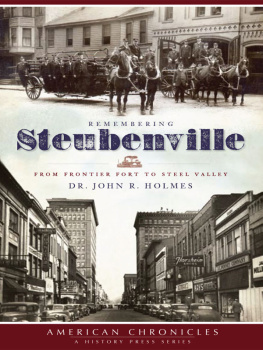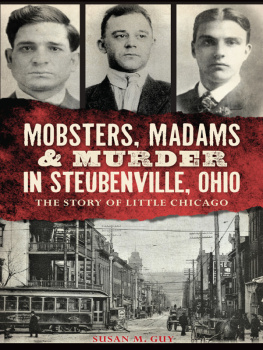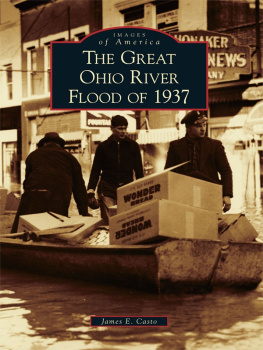

Published by The History Press
Charleston, SC 29403
www.historypress.net
Copyright 2009 by Dr. John R. Holmes
All rights reserved
First published 2009
e-book edition 2013
Manufactured in the United States
ISBN 978.1.62584.247.3
Library of Congress Cataloging-in-Publication Data
Holmes, John R. (John Robert), 1955
Remembering Steubenville : from frontier fort to steel valley / John R. Holmes.
p. cm.
Includes bibliographical references.
print edition ISBN 978-1-59629-645-9
1. Steubenville (Ohio)--History. 2. Steubenville (Ohio)--Social life and customs. I. Title.
F499.S8H65 2009
977.169--dc22
2009019599
Notice: The information in this book is true and complete to the best of our knowledge. It is offered without guarantee on the part of the author or The History Press. The author and The History Press disclaim all liability in connection with the use of this book.
All rights reserved. No part of this book may be reproduced or transmitted in any form whatsoever without prior written permission from the publisher except in the case of brief quotations embodied in critical articles and reviews.
Contents
Acknowledgements
Some of the stories in this book may already sound familiar. Well, isnt that the nature of stories that old guys tell? You hear the same ones over and over again. Members of the Steubenville Womens Club will recognize much of the Female Seminary material in this book from a play I did for them in 1998 (with my talented wife, Von, playing Hetty Beatty) and then again as a lecture in 2005. Material on the nineteenth-century industrialists of Steubenville was performed for the Jefferson County Historical Society in 1992 (also with Vons help). This book, then, owes a great deal to those groups for being preview audiences.
It also owes much, probably even more than I am aware, to the late Professor Jack Boyde of Franciscan University of Steubenville. He was a constant resource and a source of encouragement as I was first learning about this quirky and fascinating river town. Also to Dick and Elizabeth King, the driving force behind the building of Fort Steuben, making history live in Steubenville.
The sections on Fred and Dorothy Sloop are heavily indebted to conversations with clarinet virtuoso Harry Greenburg, who played with both Sloops. I hope you publish your memoirs, Harry.
But most of all, especially in the production stage of this book, the greatest debt is to the Public Library of Steubenville and Jefferson County, especially Director Alan Hall and Archivist Sandy Day. A visit to the Ohio Room at the Schiappa Branch of the PLSJC will reveal just how little this book owes to its writer and how much to the tireless labor of Alan and Sandy and their colleagues. The raw material for hundreds of books like this are in the Ohio Room. Even I cant write that much.
Introduction
I have no childhood memories of Steubenville, Ohio. Is that odd? Hardly. Because I was thirty-four years old before I even visited the city. Yet within three years of my arrival I was immersed in its history. Portraying Baron von Steuben for the first Fort Steuben Festival in 1991, I found myself in the delightful (but maybe presumptuous) position of telling Steubenville natives about their own history.
This book represents one more whack at that same audacity: an amateur historian who aint from around here presuming to tell what it was like here way back when. Begging the readers indulgence, I plead in my defense only the fact that most of the best stories in this book took place before any of the readers were born. So at least I am shielded from the charge of telling natives things that they ought to know better than I. Furthermore, most of the best stories are not the kind of legacies likely to be passed on from earlier generations. Great-grandmothers bonnet might survive in mothballs in your closet as a family treasure, but the details of where she bought it and whose attention she hoped it would attract are no doubt lost to time. Especially since she probably didnt want great-grandfather to know.
To show you what I mean, Ill tell a storythe first of many in this book. When I first spoke to the Steubenville Historical Society early in 1993, the big topic of conversation at the meeting was the impending demolition of the Hub. This aptly named department store had been the epicenter of Steubenville mercantile activity sincewell, since before anybody in the room could remember. Now, despite the actions of several historical society members then present, the building that housed the storeabandoned since 1980was about to be torn down. The store had closed five years before I came to Steubenville, so I had nothing to add to the conversation, but my kindly hosts insisted on knowing my opinion of this turn of events. Well, I ventured, Im sure that the people of Steubenville who grew up with Munkers and Sulzbachers must have felt the same sense of loss when they closed.

Market Street looking west toward Fifth Street, 1947, with the Hub at right. Ohio Collection, Schiappa Library.
Blank stares. Wrinkled foreheads. Munkers? Sulzbachers? Who are they? Then a few of the postcard aficionados remembered seeing an old tinted photocard of a Market Street scene showing the Hub on the left and Sulzbachers on the right. But no one had heard of Munkers. Now, keep in mind, I was sharing a banquet table with lifelong residents of Steubenville, some of whom were third-generation residents (or more), whose grandparents must have shopped at both Sulzbachers and Munkers only a century before. Yet scarcely any of them recognized the names of two high-volume Steubenville stores that once boasted buyers offices in London and Paris. I had chosen those names because I had naively assumed that they would be part of my hosts family memories. They clearly were not.
On reflection, however, with the hindsight of years, the blank expressions made sense. It is precisely the simple, everyday activity like shopping at Munkers that will not become part of family memory or even a citys consciousness. But the one day that President-elect Lincoln came to Steubenville (Valentines Day 1861), the big parade that welcomed Dean Martin (and Jerry Lewis) to Dean Martin Day (October 6, 1950) or the day Buffalo Bill Cody brought his Buffalo Bills Wild West show to the Hill-Top Driving Parkthose are things to tell your grandchildren.
That, in fact, is what Im trying to offer in this book: the stories I would have told my grandchildren if I had grown up in Steubenville back in the daywhen steamboats built right here plied the Ohio, run by Steubenville captains; when city council had its own one-thousand-seat opera house; and when Steubenvilles armchair sportsmen tipped back a bottle of Steuben Brew and debated (seriously) whether the new roller-skating craze would spell the end to baseball in the Ohio Valley (this was the fall of 1868). The late, great Ohio Valley historian and archaeologist, Professor Jack Boyde, used to taunt me by saying that I was only an English teacher pretending to be a historian. He was right. I am a storyteller, and these are my Steubenville stories, set in a historical frame. As such, they have no claim to comprehensiveness.
A century ago, Joseph B. Doyle published his history of Steubenville and Jefferson County at nearly 1,200 pages and about 800,000 words. With 128 pages and about 35,000 words4 percent of Doyles space, with twice as much history to coverthis book has to be more selective. There will be very important Steubenville characters and events left out. In fact, some of the better-known stories were intentionally left out precisely because they are so well known and told elsewhere. But that still leaves a lot of tidbits that havent been related in years. Im sure youll find one youll like. Pull up a chair. Pour some tea. Read a bit.
Next page









